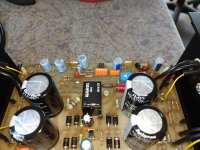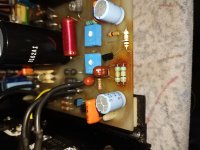Hi all again!
I'm replacing a few resistors in my Sugden monoblocks but I am not sure what to replace the coloured resistors with. What do all the different shades of blue resistors mean? Is there anyway to tell? Are they all simply 'blue' from different manufacturers? I have attached a couple photos. Particularly that big resistor inbetween the relay and cap. Does it mean they're metal film?
Also when ordering online and unsure what the resistors power rating is, is it safe to assume that if the dimensions of the resistor are the same it'll be the same power rating? I assume it's okay to replace with slightly higher power rated resistor?
Thanks,
Byron
I'm replacing a few resistors in my Sugden monoblocks but I am not sure what to replace the coloured resistors with. What do all the different shades of blue resistors mean? Is there anyway to tell? Are they all simply 'blue' from different manufacturers? I have attached a couple photos. Particularly that big resistor inbetween the relay and cap. Does it mean they're metal film?
Also when ordering online and unsure what the resistors power rating is, is it safe to assume that if the dimensions of the resistor are the same it'll be the same power rating? I assume it's okay to replace with slightly higher power rated resistor?
Thanks,
Byron
Attachments
Last edited:
The blue ones are most likely metal film the beige ones most likely carbon. If you are going to replace any just get metal film unless there is a reason not to.
Size is an indication of power rating, but some designs run hotter and can be smaller for a given power rating. Certainly you can replace a resistor with a higher power rating if it will fit.
The two 10k resistors in front of the maroon tantalum capacitor are obviously running hot given the discolouration of the circuit board underneath them. The way they are now may lead to dry joints and/or damage to the circuit board. Fit larger ones if you can, and space them 6-12mm above the circuit board, and bend the tantalum away from them so it isn't heated. The bigger surface area will run cooler, being above the board will allow air to circulate and convect heat away, and even the leads will conduct and convect heat, keeping the heat off the board. Sometimes a hole is drilled under a hot component to let air convection through the circuit board to assist with cooling.
Size is an indication of power rating, but some designs run hotter and can be smaller for a given power rating. Certainly you can replace a resistor with a higher power rating if it will fit.
The two 10k resistors in front of the maroon tantalum capacitor are obviously running hot given the discolouration of the circuit board underneath them. The way they are now may lead to dry joints and/or damage to the circuit board. Fit larger ones if you can, and space them 6-12mm above the circuit board, and bend the tantalum away from them so it isn't heated. The bigger surface area will run cooler, being above the board will allow air to circulate and convect heat away, and even the leads will conduct and convect heat, keeping the heat off the board. Sometimes a hole is drilled under a hot component to let air convection through the circuit board to assist with cooling.
If a resistor will run near its max power rating it should be mounted slightly above the pcb to avoid scorching the fibreglass and allow freer airflow.
dark brown = carbon composite (very poor, drift in value, noisy)
biege = carbon film (somewhat noisy)
blue = metal film or metal oxide. Metal film is the best for most circumstances
the colour codes can be hard to read on a blue background (especially brown v red), so I often use a meter to check the value if any uncertainty.
Modern resistors often use 5 rings, 3 digits, 1 multiplier, 1 tolerance. Sometimes its unclear which end to read from - again use a meter to be sure.
dark brown = carbon composite (very poor, drift in value, noisy)
biege = carbon film (somewhat noisy)
blue = metal film or metal oxide. Metal film is the best for most circumstances
the colour codes can be hard to read on a blue background (especially brown v red), so I often use a meter to check the value if any uncertainty.
Modern resistors often use 5 rings, 3 digits, 1 multiplier, 1 tolerance. Sometimes its unclear which end to read from - again use a meter to be sure.


